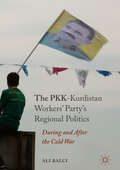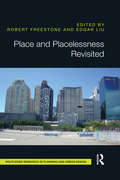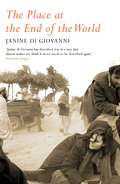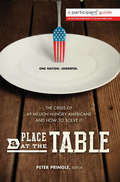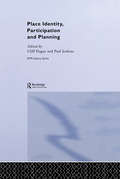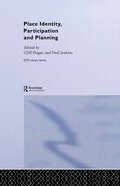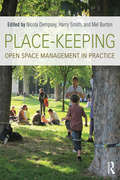- Table View
- List View
Pivoting Government through Digital Transformation (Data Analytics Applications)
by Jay LiebowitzAffecting every sector and country in the world, digital technology is changing the way citizens engage in society, companies conduct business, and governments deliver public services. The COVID-19 pandemic accelerated the pace of digitalization and exposed such vulnerabilities as inadequate infrastructure, weak regulations, and a scarcity of skilled professionals capable of digitally transforming government. Not immune to the digital revolution, governments are slowly adapting to a digital world. Governments are implementing digital solutions to deliver services to their citizens, make payments, and engage the public. Focusing on how government can transition more effectively through digital transformation, Pivoting Government Through Digital Transformation covers the following key components: Setting the stage during the Great Resignation period Filling the digital talent pipeline Best practices and vignettes for applying digital transformation in government Looking ahead towards the future Key chapter contributors from U.S. and foreign governments, as well as state and local governments, discuss how they are coping with today’s environment and how they are using digital transformation efforts to enhance their organization’s effectiveness and digital talent pipeline. With chapters on theory and practice, this groundbreaking book offers an in-depth analysis of the most innovative approaches to e-government and discusses case studies from local, state, and federal government perspectives. This is an essential guide for government employees, scholars, and regular citizens who want to make government work more effectively and democratically in the digital age.
Pivoting Government through Digital Transformation (Data Analytics Applications)
Affecting every sector and country in the world, digital technology is changing the way citizens engage in society, companies conduct business, and governments deliver public services. The COVID-19 pandemic accelerated the pace of digitalization and exposed such vulnerabilities as inadequate infrastructure, weak regulations, and a scarcity of skilled professionals capable of digitally transforming government. Not immune to the digital revolution, governments are slowly adapting to a digital world. Governments are implementing digital solutions to deliver services to their citizens, make payments, and engage the public. Focusing on how government can transition more effectively through digital transformation, Pivoting Government Through Digital Transformation covers the following key components: Setting the stage during the Great Resignation period Filling the digital talent pipeline Best practices and vignettes for applying digital transformation in government Looking ahead towards the future Key chapter contributors from U.S. and foreign governments, as well as state and local governments, discuss how they are coping with today’s environment and how they are using digital transformation efforts to enhance their organization’s effectiveness and digital talent pipeline. With chapters on theory and practice, this groundbreaking book offers an in-depth analysis of the most innovative approaches to e-government and discusses case studies from local, state, and federal government perspectives. This is an essential guide for government employees, scholars, and regular citizens who want to make government work more effectively and democratically in the digital age.
The PKK-Kurdistan Workers’ Party’s Regional Politics: During and After the Cold War
by Ali BalciThis book presents a theoretical framework to study dissident ethnic movements’ imagination of world politics, with a special focus on the PKK as a case study. Dissident ethnic movements are not only a challenge to the existing hegemonic power, but they also produce an alternative closed society based on different ethnic imagination. Instead of taking the armed PKK movement as a pure resistant, this book approaches contemporary Kurdish nationalism led by the PKK as a counter-hegemonic with a narrative that entails the emergence of a new kind of identity and sense of belonging, through which the PKK has been able to exercise its power. This book is an attempt to go beyond resistance-oriented approach, unveiling the two faces of the PKK’s representation of world politics: its transformative effect on the Kurds, and its exclusionary function towards traditional and alternative Kurdish subjects/institutions.
The PKK-Kurdistan Workers’ Party’s Regional Politics: During and After the Cold War
by Ali BalciThis book presents a theoretical framework to study dissident ethnic movements’ imagination of world politics, with a special focus on the PKK as a case study. Dissident ethnic movements are not only a challenge to the existing hegemonic power, but they also produce an alternative closed society based on different ethnic imagination. Instead of taking the armed PKK movement as a pure resistant, this book approaches contemporary Kurdish nationalism led by the PKK as a counter-hegemonic with a narrative that entails the emergence of a new kind of identity and sense of belonging, through which the PKK has been able to exercise its power. This book is an attempt to go beyond resistance-oriented approach, unveiling the two faces of the PKK’s representation of world politics: its transformative effect on the Kurds, and its exclusionary function towards traditional and alternative Kurdish subjects/institutions.
Place and Belonging in America
by David JacobsonHow did the American people come to develop a moral association with this land, such that their very experience of nationhood was rooted in, and their republican virtues depended upon, that land? And what is happening now as the exclusivity of that moral linkage between people and land becomes ever more attenuated? In Place and Belonging in America, David Jacobson addresses the evolving relationship between geography and citizenship in the United States since the nation's origins.Americans have commonly assumed that only a people rooted in a bounded territory could safeguard republican virtues. But, as Jacobson argues, in the contemporary world of transnational identities, multiple loyalties, and permeable borders, the notion of a singular territorial identity has lost its resonance. The United States has come to represent a diverse quilt of cultures with varying ties to the land. These developments have transformed the character of American politics to one in which the courts take a much larger role in mediating civic life. An expanding web of legal rights enables individuals and groups to pursue their own cultural and social ends, in contrast to the civic republican practice of an active citizenry legislating its collective life. In the first part of his sweeping study, Jacobson considers the origins of the uniquely American sense of place, exploring such components as the Puritans and their religious vision of the New World; the early Republic and agrarian virtue as extolled in the writings of Thomas Jefferson; the nationalization of place during the Civil War; and the creation of post-Civil War monuments and, later, the national park system. The second part of Place and Belonging in America concerns the contemporary United States and its more complex interactions between space and citizenship. Here Jacobson looks at the multicultural landscape as represented by the 1991 act of Congress that changed the name of the Custer Battlefield National Monument to Little Bighorn Battlefield National Monument and the subsequent construction of a memorial honoring the Indian participants in the battle; the Vietnam Veterans Memorial; and the U.S. Holocaust Memorial Museum. He also reflects upon changing patterns of immigration and settlement. At once far-reaching and detailed, Place and Belonging in America offers a though-provoking new perspective on the myriad, often spiritual connections between territoriality, national identity, and civic culture.
Place and Identity: The Performance of Home (Routledge Focus on Housing and Philosophy)
by Joanna RichardsonThe UK is experiencing a housing crisis unlike any other. Homelessness is on the increase and more people are at the mercy of landlords due to unaffordable housing. Place and Identity: Home as Performance highlights that the meaning of home is not just found within the bricks and mortar; it is constructed from the network of place, space and identity and the negotiation of conflict between those – it is not a fixed space but a link with land, ancestry and culture. This book fuses philosophy and the study of home based on many years of extensive research. Richardson looks at how the notion of home, or perhaps the lack of it, can affect identity and in turn the British housing market. This book argues that the concept of ‘home’ and physical housing are intrinsically linked and that until government and wider society understand the importance of home in relation to housing, the crisis is only likely to get worse. This book will be essential reading for postgraduate students whose interest is in housing and social policy, as well as appealing to those working in the areas of implementing and changing policy within government and professional spaces.
Place and Identity: The Performance of Home (Routledge Focus on Housing and Philosophy)
by Joanna RichardsonThe UK is experiencing a housing crisis unlike any other. Homelessness is on the increase and more people are at the mercy of landlords due to unaffordable housing. Place and Identity: Home as Performance highlights that the meaning of home is not just found within the bricks and mortar; it is constructed from the network of place, space and identity and the negotiation of conflict between those – it is not a fixed space but a link with land, ancestry and culture. This book fuses philosophy and the study of home based on many years of extensive research. Richardson looks at how the notion of home, or perhaps the lack of it, can affect identity and in turn the British housing market. This book argues that the concept of ‘home’ and physical housing are intrinsically linked and that until government and wider society understand the importance of home in relation to housing, the crisis is only likely to get worse. This book will be essential reading for postgraduate students whose interest is in housing and social policy, as well as appealing to those working in the areas of implementing and changing policy within government and professional spaces.
Place and Placelessness Revisited
by Robert Freestone Edgar LiuSince its publication in 1976, Ted Relph’s Place and Placelessness has been an influential text in thinking about cities and city life across disciplines, including human geography, sociology, architecture, planning, and urban design. For four decades, ideas put forward by this seminal work have continued to spark debates, from the concept of placelessness itself through how it plays out in our societies to how city designers might respond to its challenge in practice. Drawing on evidence from Australian, British, Japanese, and North and South American urban settings, Place and Placelessness Revisited is a collection of cutting edge empirical research and theoretical discussions of contemporary applications and interpretations of place and placelessness. It takes a multi-disciplinary approach, including contributions from across the breadth of disciplines in the built environment – architecture, environmental psychology, geography, landscape architecture, planning, sociology, and urban design – in critically re-visiting placelessness in theory and its relevance for twenty-first century contexts.
Place and Placelessness Revisited
by Robert Freestone Edgar LiuSince its publication in 1976, Ted Relph’s Place and Placelessness has been an influential text in thinking about cities and city life across disciplines, including human geography, sociology, architecture, planning, and urban design. For four decades, ideas put forward by this seminal work have continued to spark debates, from the concept of placelessness itself through how it plays out in our societies to how city designers might respond to its challenge in practice. Drawing on evidence from Australian, British, Japanese, and North and South American urban settings, Place and Placelessness Revisited is a collection of cutting edge empirical research and theoretical discussions of contemporary applications and interpretations of place and placelessness. It takes a multi-disciplinary approach, including contributions from across the breadth of disciplines in the built environment – architecture, environmental psychology, geography, landscape architecture, planning, sociology, and urban design – in critically re-visiting placelessness in theory and its relevance for twenty-first century contexts.
The Place At The End Of The World: Stories from the Frontline
by Janine Di GiovanniAt the start of her career Janine di Giovanni was advised, 'Write about the small voices, the people who can't write about themselves.'For over fifteen years, she has been doing exactly that. From a near-abandoned hospital in Chechnya to bombed-out Tora Bora in Afghanistan, from Saddam Hussein's derelict palace in Baghdad to the inner-city barrios of Kingston, Jamaica, di Giovanni has covered almost every embattled place in the world and the people caught in its midst. Like Myriem, who lives on the West Bank, but can no longer use her farm because it falls on the Israeli side of the security fence; and Sia, one of the child soldiers of Sierra Leone, who talks blithely of shedding her violent past; and Abdul, who was imprisoned by the Taliban at seventeen for not wearing a beard.The pieces collected here begin with Algeria in 1998 and end with Iraq in 2005. They are vivid, raw and impassioned - and they make war terrifyingly real.
A Place at the Table: The Crisis of 49 Million Hungry Americans and How to Solve It
by Participant MediaForty-nine million people-including one in four children-go hungry in the U.S. every day, despite our having the means to provide nutritious, affordable food for all. Inspired by the acclaimed documentary A Place at the Table, this companion book offers powerful insights from those at the front lines of solving hunger in America, including:Jeff Bridges, Academy Award-winning actor, cofounder of the End Hunger Network, and spokesperson for the No Kid Hungry Campaign, on raising awareness about hungerKen Cook, president of Environmental Working Group, unravels the inequities in the Farm Bill and shows how they affect America's hunger crisisMarion Nestle, nutritionist and acclaimed critic of the food industry, whose latest work tracks the explosion of calories in today's "Eat More” environmentBill Shore, Joel Berg, and Robert Egger, widely-published anti-hunger activists, suggest bold and diverse strategies for solving the crisisJanet Poppendieck, sociologist, bestselling author, and well-known historian of poverty and hunger in America, argues the case for school lunch reformJennifer Harris, of Yale University's Rudd Center for Food Policy and Obesity, uncovers the new hidden persuaders of web food advertisersDavid Beckmann, head of Bread for the World, and Sarah Newman, researcher on A Place at the Table, explore the intersection of faith and feeding the hungryMariana Chilton, director of Drexel University's Center for Hunger-Free Communities, discusses the health impacts of hunger and the groundbreaking Witnesses to Hunger projectTom Colicchio, chef and executive producer of television's Top Chef, presents his down-to-earth case to Washington for increases in child nutrition programsAndy Fisher, veteran activist in community food projects, argues persuasively why we have to move beyond the charity-based emergency feeding programKelly Meyer, cofounder of Teaching Gardens, illuminates the path to educating, and providing healthy food for, all childrenKristi Jacobson and Lori Silverbush, the film's directors/producers, tell their personal stories of how and why they came to make the documentaryHunger and food insecurity pose a deep threat to our nation. A Place at the Table shows they can be solved once and for all, if the American public decides-as they have in the past-that making healthy food available, and affordable, is in the best interest of us all.
Place-Based Conservation: Perspectives from the Social Sciences
by William P. Stewart, Daniel R. Williams and Linda E. KrugerThe concept of “Place” has become prominent in natural resource management, as professionals increasingly recognize the importance of scale, place-specific meanings, local knowledge, and social-ecological dynamics. Place-Based Conservation: Perspectives from the Social Sciences offers a thorough examination of the topic, dividing its exploration into four broad areas. Place-Based Conservation provides a comprehensive resource for researchers and practitioners to help build the conceptual grounding necessary to understand and to effectively practice place-based conservation.
Place-Based Evaluation for Integrated Land-Use Management
by Johan Woltjer Ernest Alexander Matthias RuthIn recent years, there has been an increasing emphasis placed on local and regional integration in major planning projects and infrastructure development including roads, rail and waterways. This emphasis is not only on integrating various projects, but also integrating them with related issues such as housing, industry, environment and water. In other words, land-use planning and infrastructure management have become more spatially-oriented. This book brings together experts in the fields of spatial planning, land-use and infrastructure management to explore the emerging agenda of spatially-oriented integrated evaluation. It weaves together the latest theories, case studies, methods, policy and practice to examine and assess the values, impacts, benefits and the overall success in integrated land-use management. In doing so, the book clarifies the nature and roles of evaluation and puts forward guidance for future policy and practice.
Place-Based Evaluation for Integrated Land-Use Management
by Johan Woltjer Ernest Alexander Matthias RuthIn recent years, there has been an increasing emphasis placed on local and regional integration in major planning projects and infrastructure development including roads, rail and waterways. This emphasis is not only on integrating various projects, but also integrating them with related issues such as housing, industry, environment and water. In other words, land-use planning and infrastructure management have become more spatially-oriented. This book brings together experts in the fields of spatial planning, land-use and infrastructure management to explore the emerging agenda of spatially-oriented integrated evaluation. It weaves together the latest theories, case studies, methods, policy and practice to examine and assess the values, impacts, benefits and the overall success in integrated land-use management. In doing so, the book clarifies the nature and roles of evaluation and puts forward guidance for future policy and practice.
Place Branding and Marketing from a Policy Perspective: Building Effective Strategies for Places (Routledge Studies in Marketing)
by Vincent Mabillard Martial Pasquier Renaud VuignierAs part of an emerging literature on place branding, this book fills the important gap between practice-oriented literature—which lacks in-depth and critical analysis—and technical academic literature—which tends to miss down-to-earth practitioners' concerns and to overlook policy and political contexts. Providing frameworks and knowledge on how to practice place branding effectively, this book anchors place-branding practices in a solid analytical framework. It presents place-branding practices through the lenses of public sector marketing, strategic management, and governance processes and structures, as well as communication tools. Marketing a place is more than creating a logo and a motto; this book presents the key strategic aspects to be considered when promoting a place. Readers will gain knowledge about the most important features of place promotion: the development of brands and marketing campaigns in the public sector, the establishment of dedicated politico-administrative structures, and the increasing involvement of various stakeholders that play a central role as place promoters. This book will be a valuable resource for researchers and postgraduate students across place branding, marketing and management, and urban studies, as well as public management, administration, and policy. The practical conclusions discussed in the book will also appeal to practitioners, business consultants, and people working in public administration and politics.
Place Branding and Marketing from a Policy Perspective: Building Effective Strategies for Places (Routledge Studies in Marketing)
by Vincent Mabillard Martial Pasquier Renaud VuignierAs part of an emerging literature on place branding, this book fills the important gap between practice-oriented literature—which lacks in-depth and critical analysis—and technical academic literature—which tends to miss down-to-earth practitioners' concerns and to overlook policy and political contexts. Providing frameworks and knowledge on how to practice place branding effectively, this book anchors place-branding practices in a solid analytical framework. It presents place-branding practices through the lenses of public sector marketing, strategic management, and governance processes and structures, as well as communication tools. Marketing a place is more than creating a logo and a motto; this book presents the key strategic aspects to be considered when promoting a place. Readers will gain knowledge about the most important features of place promotion: the development of brands and marketing campaigns in the public sector, the establishment of dedicated politico-administrative structures, and the increasing involvement of various stakeholders that play a central role as place promoters. This book will be a valuable resource for researchers and postgraduate students across place branding, marketing and management, and urban studies, as well as public management, administration, and policy. The practical conclusions discussed in the book will also appeal to practitioners, business consultants, and people working in public administration and politics.
Place Identity, Participation and Planning (RTPI Library Series)
by Cliff Hague Paul JenkinsThe central concern of this book is place identity, and its representation and manipulation through planning. Place identity is of growing international concern, both in planning practice and in academic work. The issue is important to practitioners because of the impact of globalisation on notions of place. This book includes comparisons between Norway, the Netherlands, Sweden and Scotland, focusing strongly on the question of how different spatial planning systems and practices are currently conceiving and affecting issues of place identity.
Place Identity, Participation and Planning (RTPI Library Series #Vol. 7)
by Cliff Hague Paul JenkinsThe central concern of this book is place identity, and its representation and manipulation through planning. Place identity is of growing international concern, both in planning practice and in academic work. The issue is important to practitioners because of the impact of globalisation on notions of place. This book includes comparisons between Norway, the Netherlands, Sweden and Scotland, focusing strongly on the question of how different spatial planning systems and practices are currently conceiving and affecting issues of place identity.
A Place In The Sun: Marxism And Fascimsm In China's Long Revolution
by A. James GregorChina has endured a century of turmoil, beginning with the anti-dynastic revolution associated with Sun Yat-Sen, through the military and tutelary rule of Chiang Kai-shek, the revolutionary regime of Mao Zedong, and the radical reforms of Deng Xiaoping. China has had little respite. Historians and social scientists have attempted to understand some of this history as being the consequence of the impact of European ideologies-including Marxism, Marxism-Leninism, and Fascism. Rarely instructive or persuasive, the discussions regarding this issue have, more often than not, led to puzzlement, rather than enlightenment.In A Place in the Sun, A. James Gregor offers an interpretation of the role of European Marxist and Fascist ideas on China's revolutionaries that is both original, and based on a lifetime of scholarship devoted to revolutionary ideologies. Gregor renders a detailed analysis of their respective influence on major protagonists. In the exposition, Gregor reveals an unsuspected and complex set of relationships between the Chinese revolution and essentially European ideologies. His discussion concludes with a number of estimations that suggest implications for the future of modern China, and its relationship with the advanced industrial democracies. How post-Dengist China-the world's most populous nation-is to be understood remains uncertain to most comparativists and historians. Gregor provides one well supported alternative, and he is carefully attentive to the implications of this alternative.
A Place In The Sun: Marxism And Fascimsm In China's Long Revolution
by A. James GregorChina has endured a century of turmoil, beginning with the anti-dynastic revolution associated with Sun Yat-Sen, through the military and tutelary rule of Chiang Kai-shek, the revolutionary regime of Mao Zedong, and the radical reforms of Deng Xiaoping. China has had little respite. Historians and social scientists have attempted to understand some of this history as being the consequence of the impact of European ideologies-including Marxism, Marxism-Leninism, and Fascism. Rarely instructive or persuasive, the discussions regarding this issue have, more often than not, led to puzzlement, rather than enlightenment.In A Place in the Sun, A. James Gregor offers an interpretation of the role of European Marxist and Fascist ideas on China's revolutionaries that is both original, and based on a lifetime of scholarship devoted to revolutionary ideologies. Gregor renders a detailed analysis of their respective influence on major protagonists. In the exposition, Gregor reveals an unsuspected and complex set of relationships between the Chinese revolution and essentially European ideologies. His discussion concludes with a number of estimations that suggest implications for the future of modern China, and its relationship with the advanced industrial democracies. How post-Dengist China-the world's most populous nation-is to be understood remains uncertain to most comparativists and historians. Gregor provides one well supported alternative, and he is carefully attentive to the implications of this alternative.
Place-Keeping: Open Space Management in Practice
by Nicola Dempsey Harry Smith Mel BurtonPlace-Keeping presents the latest research and practice on place-keeping – that is, the long-term management of public and private open spaces – from around Europe and the rest of the world. There has long been a focus in urban landscape planning and urban design on the creation of high-quality public spaces, or place-making. This is supported by a growing body of research which shows how high-quality public spaces are economically and socially beneficial for local communities and contribute positively to residents’ quality of life and wellbeing. However, while large amounts of capital are spent on the creation of open spaces, little thought is given to, and insufficient resources made available for, the long-term maintenance and management of public spaces, or place-keeping. Without place-keeping, public spaces can fall into a downward spiral of disrepair where anti-social behaviour can emerge and residents may feel unsafe and choose to use other spaces. The economic and social costs of restoring such spaces can therefore be considerable where place-keeping does not occur. Place-Keeping also provides an accessible presentation of the outputs of a major European Union-funded project MP4: Making Places Profitable, Public and Private Open Spaces which further extends the knowledge and debate on long-term management of public and private spaces. It will be an invaluable resource for students, academics and practitioners seeking critical but practical guidance on the long-term management of public and private spaces in a range of contexts.
Place-Keeping: Open Space Management in Practice
by Nicola Dempsey Harry Smith Mel BurtonPlace-Keeping presents the latest research and practice on place-keeping – that is, the long-term management of public and private open spaces – from around Europe and the rest of the world. There has long been a focus in urban landscape planning and urban design on the creation of high-quality public spaces, or place-making. This is supported by a growing body of research which shows how high-quality public spaces are economically and socially beneficial for local communities and contribute positively to residents’ quality of life and wellbeing. However, while large amounts of capital are spent on the creation of open spaces, little thought is given to, and insufficient resources made available for, the long-term maintenance and management of public spaces, or place-keeping. Without place-keeping, public spaces can fall into a downward spiral of disrepair where anti-social behaviour can emerge and residents may feel unsafe and choose to use other spaces. The economic and social costs of restoring such spaces can therefore be considerable where place-keeping does not occur. Place-Keeping also provides an accessible presentation of the outputs of a major European Union-funded project MP4: Making Places Profitable, Public and Private Open Spaces which further extends the knowledge and debate on long-term management of public and private spaces. It will be an invaluable resource for students, academics and practitioners seeking critical but practical guidance on the long-term management of public and private spaces in a range of contexts.
Place-making and Policies for Competitive Cities
by Sako MusterdUrban policy makers are increasingly striving to strengthen the economic competitiveness of their cities. Currently, they do that mainly in the field of the creative knowledge economy - arts, media, entertainment, creative business services, architecture, publishing, design; and ICT, R&D, finance, and law. This book is about the policies that help to realise such objectives: policies driven by classic location theory, cluster policies, ‘creative class’ policies aimed at attracting talent, as well as policies that connect to pathways, place and personal networks. The experiences and policy strategies of 13 city-regions across Europe have been investigated: Amsterdam, Barcelona, Birmingham, Budapest, Dublin, Helsinki, Leipzig, Milan, Munich, Poznan, Riga, Sofia and Toulouse. All have different histories and roles: capital cities and secondary cities; cities with different economies and industries; port-based cities and land-locked cities. And all 13 have different cultural, political and welfare state traditions. Through this wide set of contexts, Place-making and Policies for Competitive Citiescontributes to the debate about the development of creative knowledge cities, their economic growth and competitiveness and advocates the development of context-sensitive tailored approaches. Chapter authors from the 13 European cities rigorously evaluate, reformulate and test assumptions behind old and new policies. This solidly-grounded and policy-focused study on the urban policy of place-making highlights practices for different contexts in managing knowledge-intensive cities and, by drawing on the varied experiences from across Europe, it establishes the state-of-the-art for both academic and policy debates in a fast-moving field.
Place-making and Policies for Competitive Cities
by Sako Musterd Zoltán KovácsUrban policy makers are increasingly striving to strengthen the economic competitiveness of their cities. Currently, they do that mainly in the field of the creative knowledge economy - arts, media, entertainment, creative business services, architecture, publishing, design; and ICT, R&D, finance, and law. This book is about the policies that help to realise such objectives: policies driven by classic location theory, cluster policies, ‘creative class’ policies aimed at attracting talent, as well as policies that connect to pathways, place and personal networks. The experiences and policy strategies of 13 city-regions across Europe have been investigated: Amsterdam, Barcelona, Birmingham, Budapest, Dublin, Helsinki, Leipzig, Milan, Munich, Poznan, Riga, Sofia and Toulouse. All have different histories and roles: capital cities and secondary cities; cities with different economies and industries; port-based cities and land-locked cities. And all 13 have different cultural, political and welfare state traditions. Through this wide set of contexts, Place-making and Policies for Competitive Citiescontributes to the debate about the development of creative knowledge cities, their economic growth and competitiveness and advocates the development of context-sensitive tailored approaches. Chapter authors from the 13 European cities rigorously evaluate, reformulate and test assumptions behind old and new policies. This solidly-grounded and policy-focused study on the urban policy of place-making highlights practices for different contexts in managing knowledge-intensive cities and, by drawing on the varied experiences from across Europe, it establishes the state-of-the-art for both academic and policy debates in a fast-moving field.
Place-Name Politics in Multilingual Areas: A Comparative Study of Southern Carinthia (Austria) and the Těšín/Cieszyn Region (Czechia) (Palgrave Studies in Minority Languages and Communities)
by Peter Jordan Přemysl Mácha Marika Balode Luděk Krtička Uršula Obrusník Pavel Pilch Alexis Sancho ReinosoThis book explores the role of place names in the formation and maintenance of individual and group identities in multilingual and multi-ethnic situations. Using examples from Austria and Czechia as case studies, the authors examine the power of place names through an interdisciplinary and multi-methods approach that draws from the fields of anthropology, geography, sociolinguistics and toponomastics. The book contextualises both places within their social and political histories, and probes recent debates in the social sciences relating to place names, identity and power. It will be of interest to scholars and students focusing on place names and naming practices, minority communities and languages, and linguistic landscapes.

